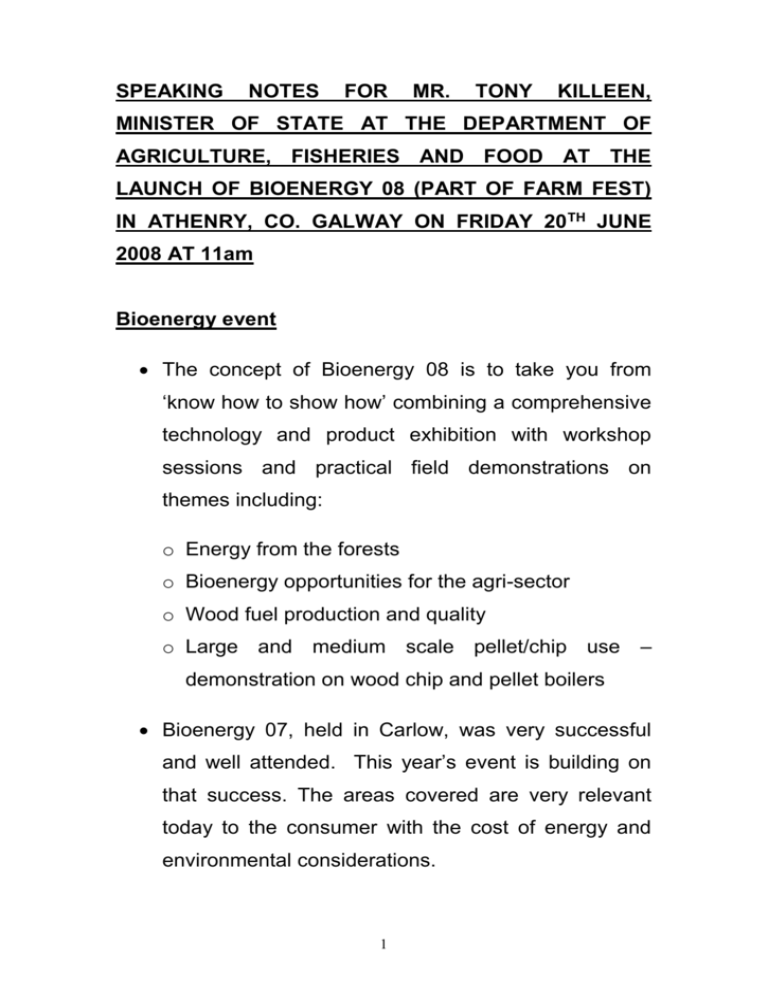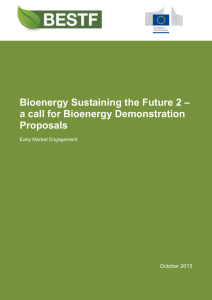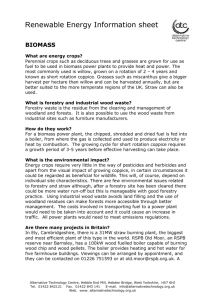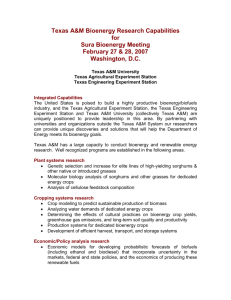DRAFT SPEECH MATERIAL IN RELATION TO FORESTRY FOR
advertisement

SPEAKING NOTES FOR MR. TONY KILLEEN, MINISTER OF STATE AT THE DEPARTMENT OF AGRICULTURE, FISHERIES AND FOOD AT THE LAUNCH OF BIOENERGY 08 (PART OF FARM FEST) IN ATHENRY, CO. GALWAY ON FRIDAY 20TH JUNE 2008 AT 11am Bioenergy event The concept of Bioenergy 08 is to take you from ‘know how to show how’ combining a comprehensive technology and product exhibition with workshop sessions and practical field demonstrations on themes including: o Energy from the forests o Bioenergy opportunities for the agri-sector o Wood fuel production and quality o Large and medium scale pellet/chip use – demonstration on wood chip and pellet boilers Bioenergy 07, held in Carlow, was very successful and well attended. This year’s event is building on that success. The areas covered are very relevant today to the consumer with the cost of energy and environmental considerations. 1 The development of bioenergy offers benefits for forest owners and managers, project developers, consumers, local communities and the environment. Organisers COFORD (National Council for Forest Research and Development), Sustainable Energy Ireland (SEI) and Teagasc are to be congratulated on their organization of such a major showcase event The event is being held this year in conjunction with Teagasc’s bi-annual event ‘Farmfest’, which focuses on the many enterprises and issues surrounding farming and rural living. Both events should thereby benefit from a wider audience. Main function of event The main function of the Bioenergy 08 event is to raise awareness across all sectors on the many uses and benefits of growing, harvesting and using wood fuels and energy crop products to generate heat, electricity and fuel for our homes and businesses. 2 Easily accessible information on bioenergy, and its uses and benefits, fosters awareness about bioenergy and is particularly welcome given the policy decisions relating to energy at both EU and national level. EU Policy The EU agreed last year that, EU-wide, renewables would account for 20% of overall energy mix by 2020 – a threefold increase on existing levels. This is particularly relevant for Ireland as we are disproportionately dependent on imported energy at close to 90% compared to the EU average of 50%. For these reasons, we urgently need to develop alternative renewable sources of energy. Government Policy Recognising the importance of this bioenergy sectors the Government established a Ministerial Taskforce on Bioenergy in 2006. The Taskforce produced a comprehensive National Bioenergy Action Plan detailing over 50 Actions to increase the share of renewable energy derived Bioenergy Sectors. 3 from the Biomass/ The Action plan complements the recent EU package of Energy – Climate change measures which require Ireland to obtain 16 per cent of our energy from renewable sources and to ensure that biofuels make up 10 per cent of transport fuel by 2020. Oil prices With oil and other fossil fuels at record price levels, the need for alternative home produced, secure, sources of energy is becoming more important all the time. Climate change Climate change is also another challenge facing us all. It is now, scientifically, well established that global warming and climate change are issues that we must tackle to ensure the well being of our planet for future generations. Reductions in carbon emissions are a must and we can all play out part in achieving this. Good News The good news is that there are many potential alternative and climate friendly renewable sources of energy that we can exploit. 4 The key words here are ‘renewable’ and ‘climatefriendly’. Bio energy, which is a clean, renewable, source of energy, is one way of responding to this challenge. These potential sources of bioenergy include conventional agricultural crops such as oil seed rape, willow, miscanthus and wood by-products. There is also the potential to recover a range of agriculture and food wastes for conversion to energy. And as new second-generation technologies are developed, we will be able to expand the feedstock base further to convert biomass, such as straw, into liquid biofuels. This Bioenergy event is focussing on solid biomass fuels such as wood, willow and miscanthus. Wood in its many forms, miscanthus and other agriculture crops have the potential to significantly contribute to Ireland reducing its dependence on imported fossil fuels. 5 The role of forestry in our National Climate Change Strategy, through its absorption of carbon, is also important. The ability of farmers to produce carbon neutral, renewable energy, particularly through the sale of thinnings given the oil price level, will reflect growing profitability and self-reliance. I believe Ireland’s agriculture and forestry sectors can make a major contribution to reaching the various targets. Agriculture can supply many primary feedstocks for bioenergy including energy crops. Forestry In relation to the potential of forestry, I would like to point out that the current forestry programme creates the opportunity for a major transformation in Irish farming, which can underpin the long-term economic viability of many holdings. For the wider community forestry also creates employment, often in remote rural areas where opportunities are limited. 6 The exploitation of the energy potential of biomass will create another important market for farm produce and it can make marginal profit making management activities such as first thinning more financially beneficial to the forest owner. Long term benefits of forestry for landowner All in all forestry is an enterprise that all landowners should look at closely. Forests can make an ideal pension investment with substantial tax-free benefits. There is no reason why more farmers cannot integrate some forestry with their other farming enterprises. This would boost their income immediately and deliver benefits that will accrue in the long term both to themselves and the wider community. A 100 % planting grant and a 20-year premium of up to €574 euro per hectare per annum in some cases, deserves serious consideration by farmers. 7 In 2007, a total of just over €71 million was paid in forestry premium to plantation owners nationwide, most of whom are farmers. In addition to the regular income over the initial years, there is also the end value of the timber crop. Bioenergy Scheme The Department is also promoting the production of energy crops as an alternative land use option. We believe this area can provide a new source of income for farmers and other landowners. In 2007, the Department launched a new Bioenergy Scheme offering establishment grants to farmers of up to €1,450 per hectare to plant willow and miscanthus. Some 800 hectares were grant aided in 2007 and a further 1,200 hectares have been granted pre-planting approval in 2008. Farmers can also avail of an EU premium worth €45 per hectare under the EU Energy Crops Scheme to grow energy crops. 8 As a further incentive, the Department introduced a new National Energy Crop Premium in 2007 worth €80 per hectare. Areas sown with energy crops also qualify for the Single Farm payment. Wood energy & forestry The use of wood fuel for energy generation is a new and growing sustainable industry, with potential for considerable expansion within the farming sector. In addition to offering benefits for forest owners, it also benefits consumers, local communities and the environment. Biomass has the potential to redirect hundreds of millions of euro to the Irish economy, create new jobs in fuel supply and meet up to 10% of our energy needs by 2020. In order to increase the supply of wood biomass from Ireland’s forest estate, my Department introduced the ‘Wood-Biomass Harvesting Machinery Grant Scheme’ in 2007. The idea was to ‘kick-start’ the process by providing grant-aid for the purchase of large and medium scale chipper units, which are essential components of the Irish supply chain. 9 Some €0.5m in grant-aid was approved under phase 1 of the scheme, supporting the purchase of 4 large chipper units, along with one of the smaller mobile chipper units. I am delighted to announce that I have just approved grant-aid for a further two mobile units and I would like congratulate the successful applicants, Michael Quirke of Caherciveen, Co. Kerry and Sean T. O’Malley of Ballina, Co. Mayo and wish them well in their new ventures. Wood chip, wood pellet, miscanthus and willow can all provide fuel for use in domestic and commercial biomass boilers. Many homes, hospitals and office buildings in Ireland are now moving towards biomass boilers following the introduction of generous grants under the Greener Homes and Bio heat Schemes. The response to these schemes has been very positive reflecting the strong public interest in renewable energy. These initiatives will stimulate demand for biomass feed stocks such as wood chip and wood pellet and for renewable technologies. 10 Producer Groups Another initiative currently underway is a number of pilot ‘Forestry Producer Group’ type projects, funded by my Department, such as the ‘Clare Wood Energy Project’ in Clare, the ‘Forest Link’ project in Donegal and the ‘Cork and Galway Producer Group Project’. These projects are aimed at providing a number of benefits including the better marketing of wood produced by farmer/foresters and also giving a kickstart to the creation, in a coordinated way, of a wood fuel supply network. Research and Development Bioenergy is a rapidly developing area and I recognise the need to focus on research and development. The Department has provided over €6 million in funding for projects that relate directly to biofuels and energy crops through the Department’s Research Stimulus Fund Programme. The research covers a broad range of agri-energy topics including energy crop production. 11 COFORD, one of the organisers of today’s event, funds and co-ordinates forestry research and development and is doing significant work in development of the wood energy sector, in conjunction with other bodies including Sustainable Energy Ireland and Teagasc. Bioenergy also offers wider environmental benefits including alternative means to dispose of farm waste products. The Department is supporting efforts to convert waste to energy that would deliver financial benefits for the industries involved, reduce disposal costs and represent a significant bioenergy contribution from agriculture. In this regard, the Department has provided some €4 million to support the development of on farm demonstration units such as Anaerobic Digestion. Concluding remarks The Bioenergy 2008 exhibition provides visitors access to the latest product innovation from suppliers within the national bioenergy sector. 12 Ample outdoor space together with the indoor exhibition will showcase and demonstrate machinery and equipment such as domestic pellet stoves and boilers, commercial wood pellet/chip boilers, chippers, residue bundlers to name but a few. The many exhibition stands will answer your questions about boilers, stoves, wood chips, briquettes, pellets, sawdust, recycled crushed wood and logs. BioEnergy 2008 gives us the opportunity to see at first hand and appreciate the alternatives available. This is a learning process and, once again, I want to congratulate the organisers for bringing all of this together. I am sure that you will all find it more informative and useful and that you will go away with a better understanding of what bioenergy means and how it can benefit us all. Thank you for your attention. ENDS. 13




